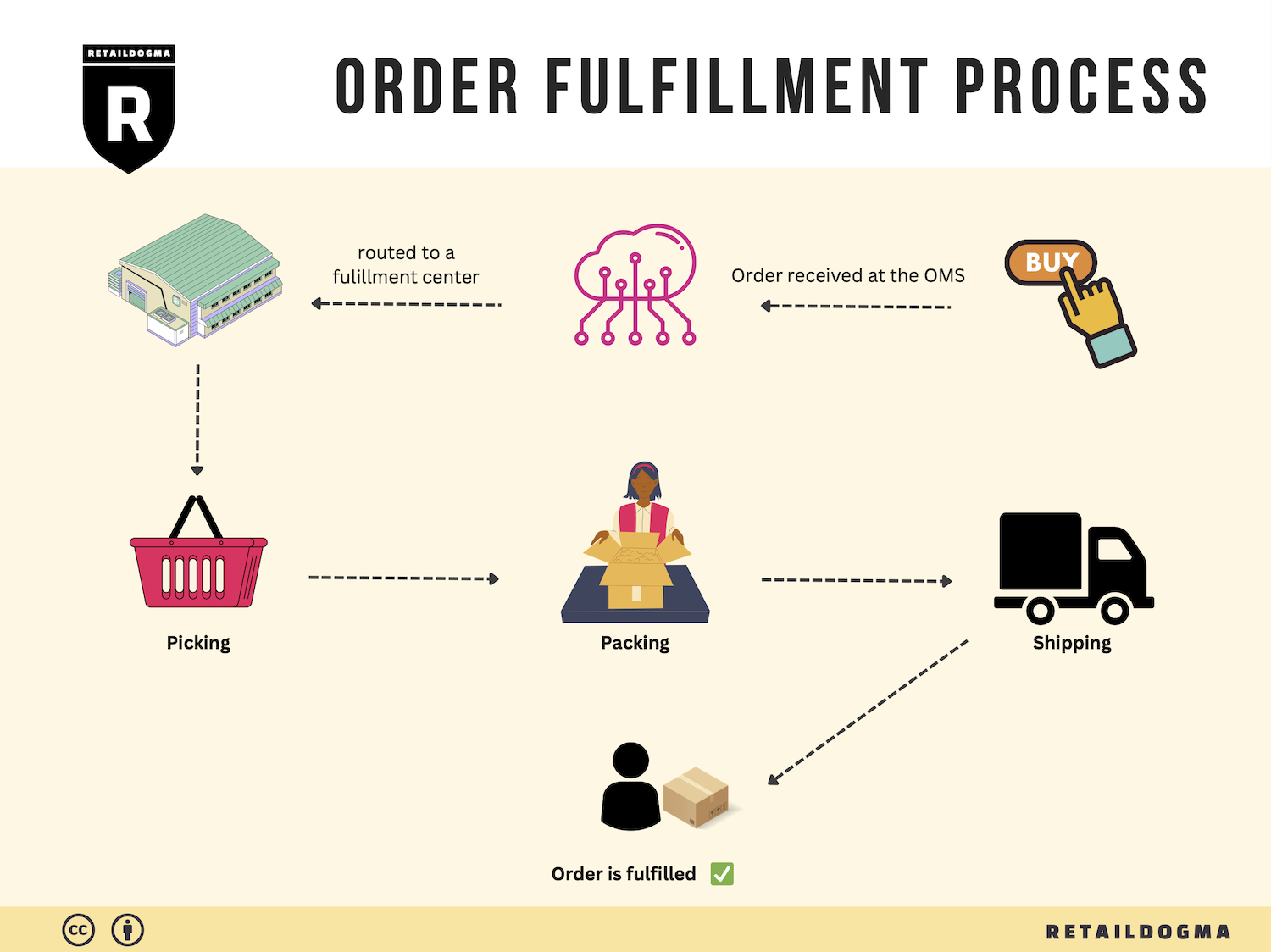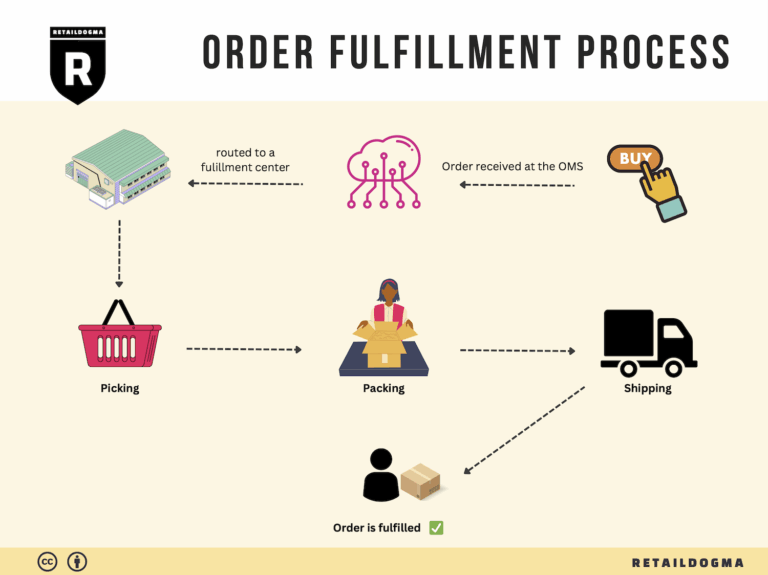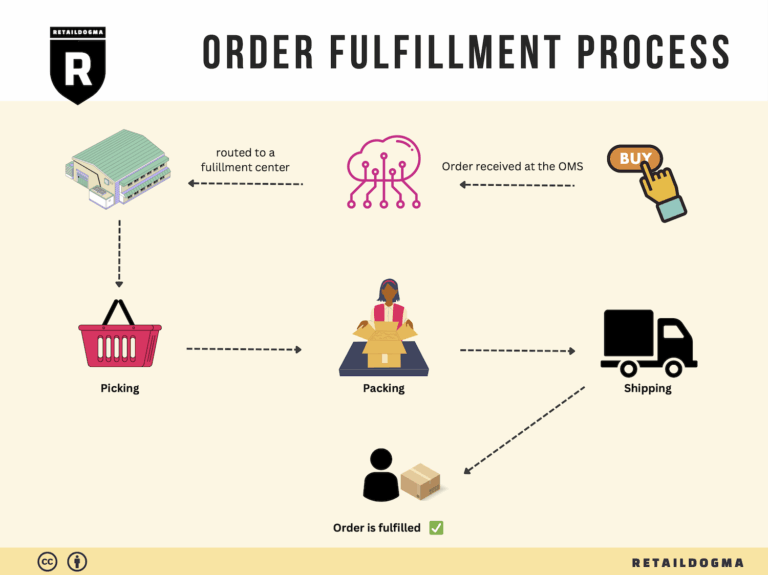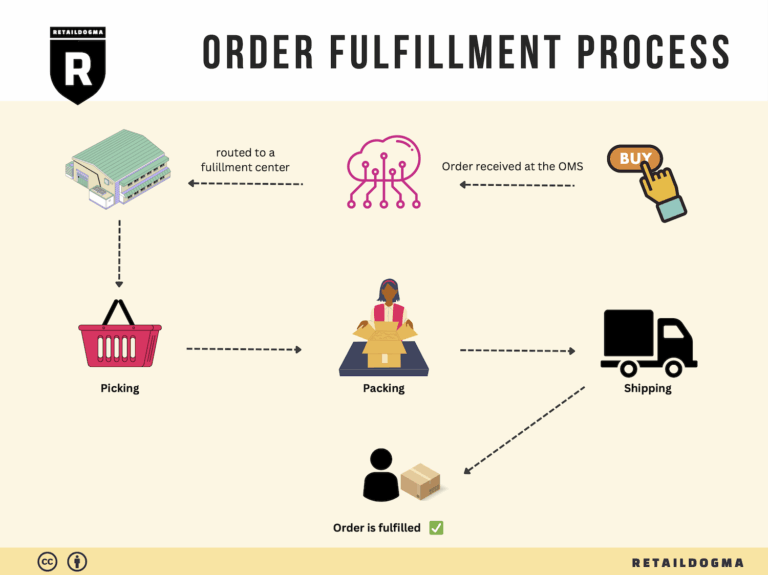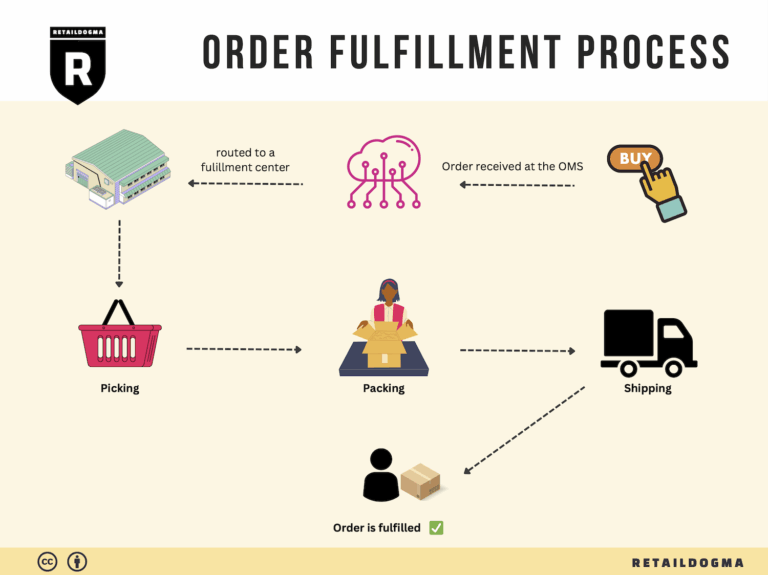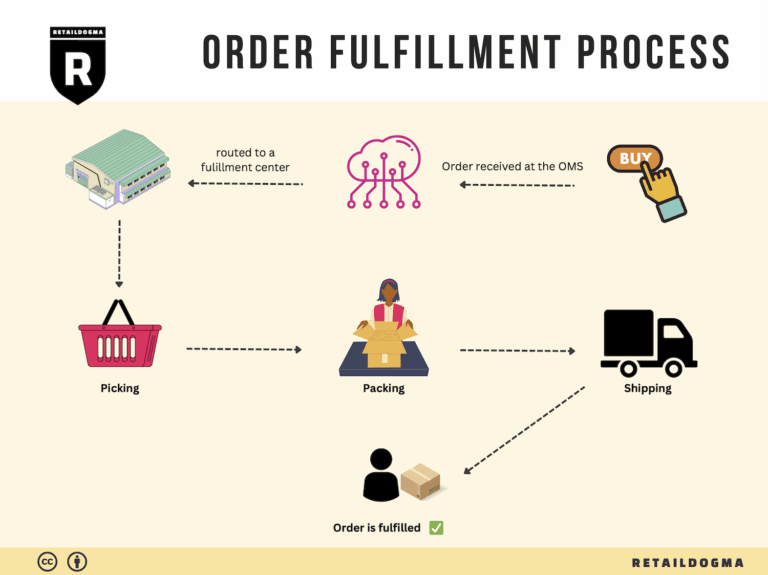How Order Fulfillment Works: A Step-by-Step Guide for Businesses
What is E-commerce Fulfillment? An Introduction for Growing Businesses
Understanding the Challenges of E-commerce Fulfillment
As an e-commerce business owner, you may find yourself overwhelmed by the complexities of packing and shipping orders. The excitement of growing sales can quickly turn into frustration when faced with the logistical challenges of getting products into the hands of customers. This is where effective fulfillment strategies come into play. Fulfillment is the backbone of your e-commerce operations, encompassing the entire process of getting a product from your inventory to a customer’s doorstep.
Defining E-commerce Fulfillment
In simple terms, e-commerce fulfillment is the process that involves warehousing, picking, packing, and shipping products. It is critical for ensuring that your customers receive their orders accurately and on time. The efficiency of your fulfillment operations can significantly influence customer satisfaction, repeat business, and ultimately, your bottom line.
What This Guide Will Cover
This guide will navigate you through the various models of e-commerce fulfillment, such as third-party logistics (3PL) and Amazon’s Fulfillment by Amazon (FBA). Each model has its unique advantages and considerations, and understanding these can help you choose the best fit for your business.
We will delve into the core services involved in e-commerce fulfillment, including inventory management, order processing, and shipping logistics. Knowing what services are essential will allow you to streamline your operations and focus on growth.
Choosing the right fulfillment partner is another critical aspect we will explore. Factors such as reliability, technology integration, and cost-effectiveness are vital in making an informed decision that aligns with your business goals.
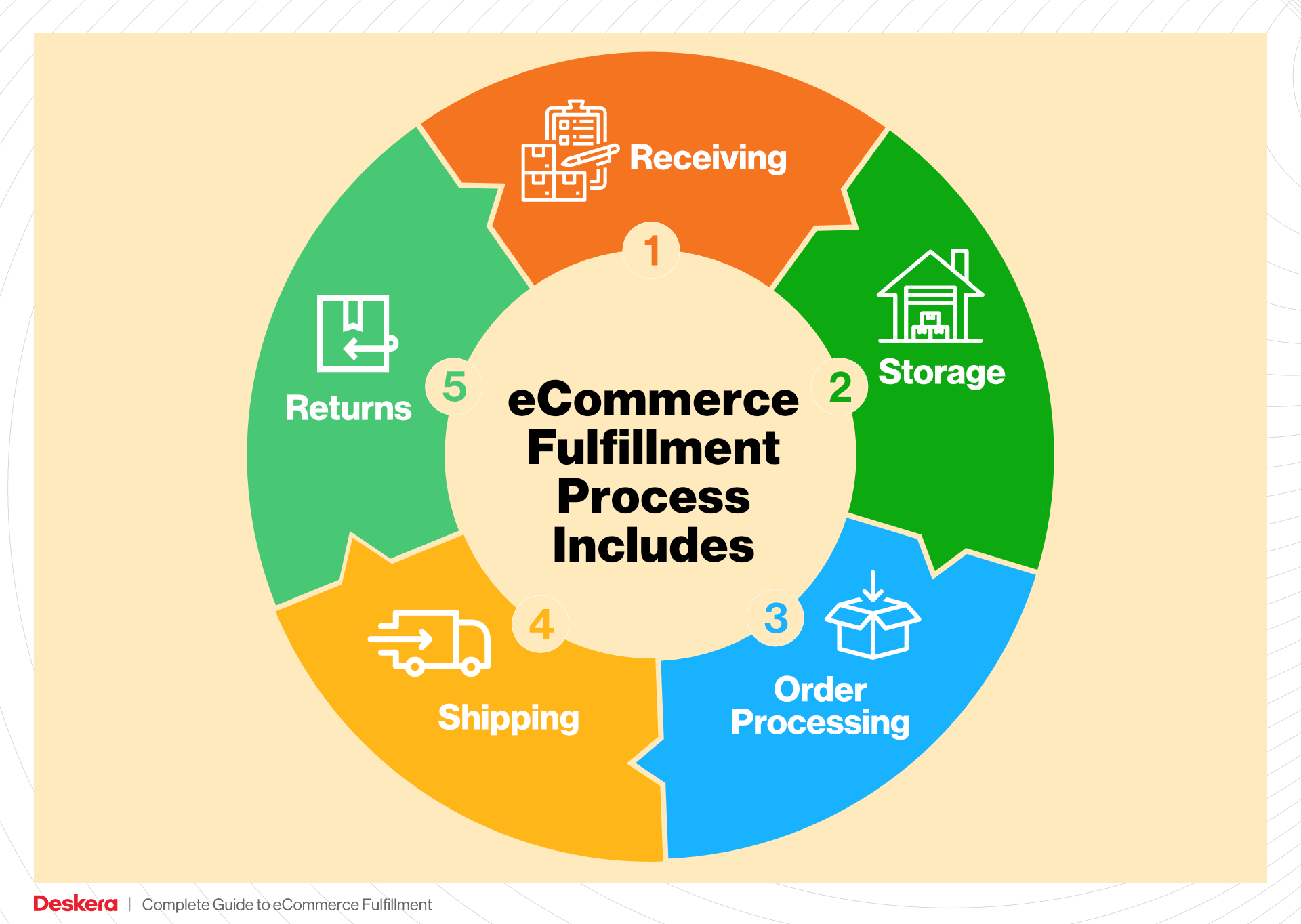
Finally, we’ll discuss pricing structures within fulfillment services. Understanding how costs are calculated—be it per order, weight, or volume—will empower you to budget effectively and maximize profitability.
Empowering Your Business Decisions
The ultimate goal of this guide is to empower you, the e-commerce business owner, to make smart, informed decisions about your logistics. By demystifying the fulfillment process and providing actionable insights, we aim to help you navigate the complexities of e-commerce fulfillment with confidence. Whether you are just starting or looking to scale your operations, this guide is designed to support you every step of the way.
What You’ll Learn In This Guide
- What is E-commerce Fulfillment? An Introduction for Growing Businesses
- The Order Fulfillment Process: From ‘Buy’ Button to Customer’s Door
- Comparing Fulfillment Models: In-House vs. 3PL vs. Dropshipping
- A Deep Dive into Amazon FBA: Pros, Cons, and Who It’s For
- Core Services Offered by Fulfillment Centers
- How to Choose a Fulfillment Partner: A 6-Point Checklist
- Understanding Fulfillment Pricing: A Breakdown of Common Fees
- Frequently Asked Questions (FAQs) about Fulfillment
- Conclusion: Is Outsourcing Fulfillment the Right Move for Your Business?
- Important Disclaimer
The Order Fulfillment Process: From ‘Buy’ Button to Customer’s Door
1. Receiving Inventory
The order fulfillment process begins with receiving inventory at the fulfillment center (FC). Once products are shipped from suppliers or manufacturers, they arrive at the designated warehouse, where they are checked for accuracy and quality. This step is critical because it ensures that the correct quantities and items are received, preventing discrepancies that could lead to stockouts or overstock situations.
During this stage, each item is logged into the inventory management system using a unique identifier known as a Stock Keeping Unit (SKU). The SKU allows for easy tracking and management of inventory levels. Proper receiving protocols help in identifying any damaged goods and verifying that the shipment matches the purchase order.
Importance: Efficient receiving processes minimize errors and lay the groundwork for smooth operations throughout the fulfillment cycle. If receiving is handled poorly, it can lead to issues such as incorrect inventory levels, which can directly affect order fulfillment and customer satisfaction.
2. Warehouse Storage
Once inventory has been received and checked, the next step is warehouse storage. This involves placing the products in designated storage locations within the fulfillment center. Effective warehousing practices are essential for maintaining an organized inventory system, which allows for quick retrieval of items when orders are placed.
Products are often categorized and stored based on factors such as size, weight, and demand frequency. Utilizing a systematic approach like bin locations or zones helps in optimizing the space and improving accessibility. Key terms associated with this step include “FIFO” (First In, First Out) and “LIFO” (Last In, First Out), which dictate the order in which products are picked based on their arrival dates.
Importance: Proper warehouse storage reduces the time taken to locate items during the picking process and helps maintain an organized inventory. This efficiency is crucial for maintaining a high throughput of orders, especially during peak seasons.
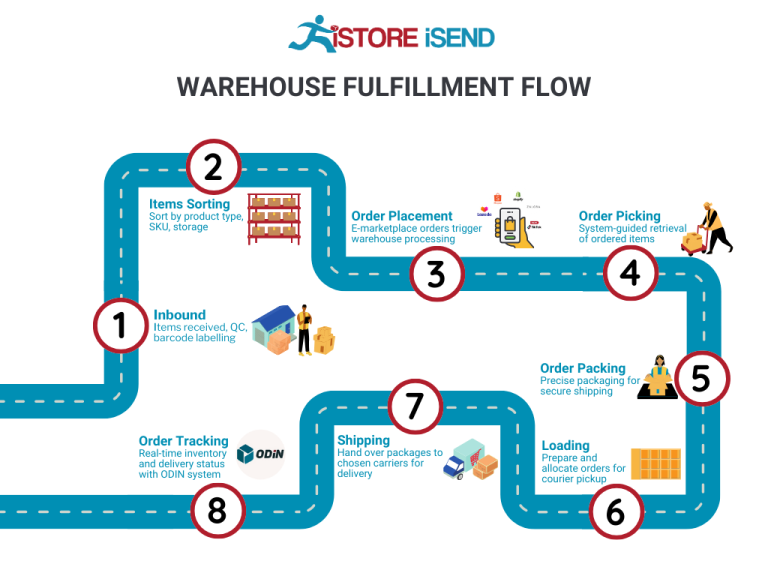
3. Order Picking
Order picking is the process of retrieving products from storage to fulfill customer orders. When an order is placed, the fulfillment center generates a pick list that details which items need to be collected and their respective locations. This step can be completed using various methods, including single-order picking, batch picking, or wave picking, depending on the scale of operations and order volume.
The efficiency of order picking significantly impacts fulfillment speed. Technologies such as barcode scanners and mobile picking devices can enhance accuracy and speed, ensuring that the right products are selected. Additionally, employing techniques like zone picking can minimize travel time for pickers by assigning specific areas for them to work in.
Importance: Effective order picking is critical for meeting customer expectations for delivery speed and accuracy. Errors in this step can lead to incorrect shipments, resulting in customer dissatisfaction and increased return rates.
4. Order Packing
After items are picked, they move to the packing station, where they are prepared for shipment. This involves checking the picked items against the order to ensure accuracy, followed by packing them securely in boxes or envelopes. Proper packing techniques are crucial for protecting items during transit and minimizing damage.
Key considerations in the packing process include selecting appropriate packaging materials, calculating shipping costs, and labeling parcels accurately. Automation in packing can streamline the process, allowing for faster turnaround times and reducing labor costs. Terms like “dimensional weight” (DIM weight) are important here, as they affect shipping costs based on the size of the package rather than just its weight.
Importance: Efficient packing is vital for ensuring that orders arrive at customers’ doors in excellent condition, which directly influences customer satisfaction and return rates. The packing stage also provides an opportunity to include promotional materials or personalized notes, enhancing the overall customer experience.
5. Shipping & Delivery
The final step in the order fulfillment process is shipping and delivery. Once packed, orders are handed over to shipping carriers for transport to customers. This stage involves selecting the most cost-effective and efficient shipping method based on factors like delivery speed, destination, and package weight.
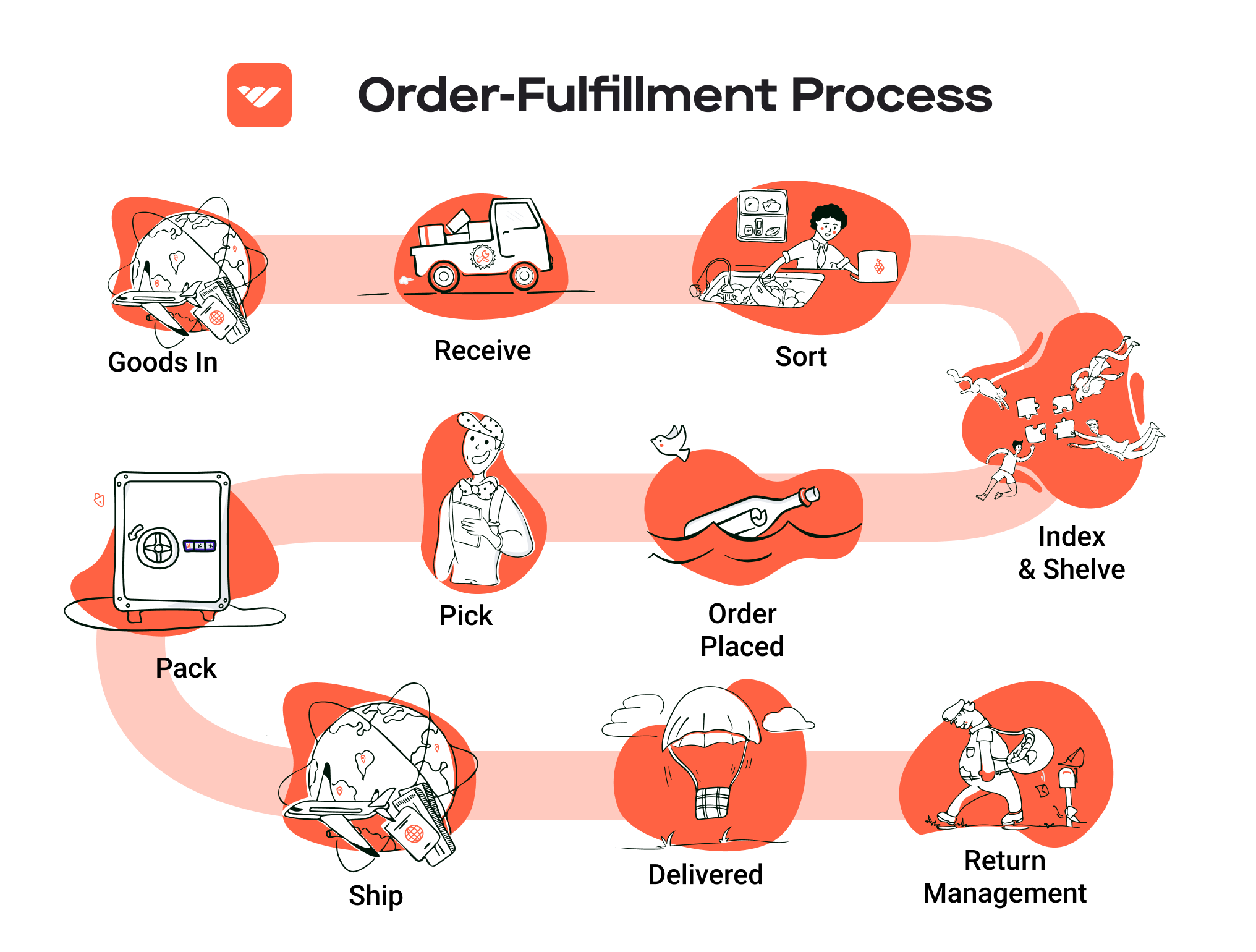
Tracking shipments is a key component of this stage, as it allows customers to monitor their order’s progress in real-time. Effective shipping practices also involve understanding the logistics of various carriers and optimizing routes to minimize delivery times and costs. Terms such as “last mile delivery” are crucial, as this refers to the final leg of the shipping journey, which can significantly impact customer satisfaction.
Importance: Timely and accurate shipping is critical for customer retention and brand loyalty. In a competitive e-commerce landscape, the ability to deliver products quickly and reliably can set businesses apart and drive repeat purchases. Ensuring a seamless shipping process is essential for maintaining a strong reputation and achieving long-term success in e-commerce.
Comparing Fulfillment Models: In-House vs. 3PL vs. Dropshipping
Fulfillment Model Comparison Table
| Model | Who Handles Inventory | Best For (Business Stage) | Key Advantage | Key Disadvantage |
|---|---|---|---|---|
| In-House Fulfillment | Your own team | Established businesses | Full control over inventory and processes | High overhead costs and complexity |
| Third-Party Logistics (3PL) | A third-party provider | Growing businesses | Scalability and reduced operational burden | Less control over inventory management |
| Dropshipping | Supplier/manufacturer | Startups and small businesses | Low upfront investment and risk | Lower profit margins and reliance on suppliers |
In-House Fulfillment
In-house fulfillment involves managing all aspects of inventory handling, storage, and shipping within your own facilities. This model is ideal for established businesses that have a steady flow of orders and sufficient resources to invest in inventory management. The key advantage of in-house fulfillment is the level of control it provides. Businesses can oversee every aspect of the supply chain, from quality control to shipping times, ensuring that customer expectations are met consistently. This control also allows for the customization of packaging and branding, which can enhance the customer experience.
However, the disadvantages are significant. In-house fulfillment often requires a considerable investment in warehouse space, technology, and staff. This model can lead to high overhead costs, particularly for businesses that experience seasonal fluctuations in demand. Moreover, as the business scales, managing an in-house fulfillment operation can become increasingly complex, requiring sophisticated inventory management systems and processes to avoid issues like stockouts or overstocking.
Third-Party Logistics (3PL)
Third-party logistics (3PL) providers handle various aspects of logistics on behalf of businesses. This model is particularly beneficial for growing businesses that need to scale their operations without the complexities of managing fulfillment in-house. By outsourcing logistics to a 3PL, businesses can focus on core activities such as marketing and product development, while the 3PL manages warehousing, inventory management, and shipping.
One of the key advantages of using a 3PL is scalability. As demand for products increases, 3PLs can quickly adapt by expanding storage capacity and optimizing distribution networks, allowing businesses to respond effectively to market changes. Additionally, 3PLs often have established relationships with carriers, which can lead to reduced shipping costs and faster delivery times.
However, outsourcing fulfillment also has its drawbacks. Businesses may lose a degree of control over inventory management and fulfillment processes, which can lead to miscommunication and errors. Moreover, relying on a third-party provider means that businesses must ensure their 3PL partner aligns with their standards for customer service and quality, which can be challenging to manage.
Dropshipping
Dropshipping is a fulfillment model where businesses sell products they don’t physically hold in stock. Instead, when an order is placed, the product is purchased from a third-party supplier who ships it directly to the customer. This model is particularly appealing for startups and small businesses due to its low upfront investment and minimal financial risk.
The primary advantage of dropshipping is that it eliminates the need for inventory management and storage, significantly reducing overhead costs. Entrepreneurs can test new products and markets without committing capital to inventory. This flexibility allows businesses to adapt quickly to consumer preferences and market trends.
However, dropshipping is not without its challenges. The biggest drawback is the lower profit margins, as retailers often have to price their products competitively while sharing profits with suppliers. Additionally, businesses are reliant on suppliers for product quality and shipping times, which can lead to inconsistencies in customer experience. If a supplier runs out of stock or experiences delays, it can reflect poorly on the retailer, potentially harming their reputation.
Conclusion
Choosing the right fulfillment model is a critical decision for e-commerce businesses. Each model—In-House Fulfillment, Third-Party Logistics, and Dropshipping—has its unique benefits and challenges. Businesses must carefully evaluate their current stage, operational capabilities, and long-term goals to select the most suitable option. By understanding these fulfillment models, entrepreneurs can better position themselves for scalability and success in the competitive e-commerce landscape.
A Deep Dive into Amazon FBA: Pros, Cons, and Who It’s For
Understanding Fulfillment by Amazon (FBA)
Fulfillment by Amazon (FBA) is a service offered by Amazon that allows sellers to store their products in Amazon’s fulfillment centers. Amazon takes on the responsibility of storage, packaging, and shipping of products directly to customers. This service is particularly beneficial for e-commerce businesses looking to scale their operations without the overhead of managing their own logistics.
How FBA Works
The FBA process begins when a seller creates an Amazon seller account and lists their products on the platform. Once the products are listed, the seller ships their inventory to one or more of Amazon’s fulfillment centers. Here’s a breakdown of the key steps involved in FBA:
-
Product Listing: Sellers create product listings on Amazon, specifying details such as product descriptions, images, and prices.
-
Inventory Shipment: Sellers prepare and ship their inventory to Amazon’s fulfillment centers. They need to follow Amazon’s packaging and labeling guidelines to ensure smooth processing.
-
Storage: Once received, Amazon stores the products in their warehouses. The inventory is categorized and made available for sale on Amazon’s marketplace.
-
Order Fulfillment: When a customer places an order, Amazon handles the picking, packing, and shipping of the product. They also manage customer service and returns, allowing sellers to focus on other aspects of their business.
-
Payment: After the order is fulfilled, Amazon collects the payment from the customer and disburses the seller’s share, minus any applicable fees.
Pros of Using Amazon FBA
-
Prime Eligibility: One of the most significant advantages of FBA is that products become eligible for Amazon Prime. This can dramatically increase sales, as Prime members prefer items that offer free two-day shipping.
-
Customer Trust: Amazon is a trusted platform among consumers. By utilizing FBA, sellers leverage Amazon’s reputation, which can lead to increased sales and customer loyalty.
-
Multi-Channel Fulfillment: FBA is not limited to Amazon sales. Sellers can use FBA to fulfill orders from other platforms, such as their own websites or eBay, streamlining their operations.
-
Scalability: FBA allows sellers to scale their business without the burden of managing logistics. Amazon’s vast network of fulfillment centers can accommodate increased inventory and order volume.
-
Time-Saving: By outsourcing fulfillment to Amazon, sellers can save time and resources, allowing them to focus on marketing, product development, and customer engagement.
Cons of Using Amazon FBA
-
High Fees: FBA comes with various fees, including storage fees, fulfillment fees, and long-term storage fees. These costs can add up, especially for sellers with slow-moving inventory or seasonal products.
-
Strict Inventory Rules: Amazon imposes stringent guidelines regarding inventory management, packaging, and labeling. Sellers must adhere to these rules to avoid penalties, which can be a challenge for some businesses.
-
Commingling Risks: FBA utilizes a commingled inventory model, meaning that products from different sellers may be stored together. This can lead to issues if a customer receives a damaged or defective item that is not from the seller’s stock.
-
Loss of Control: By outsourcing fulfillment, sellers lose some control over the shipping process and customer experience. Any delays or issues with Amazon’s logistics can directly impact the seller’s reputation.
-
Inventory Management Challenges: Sellers must keep a close eye on their inventory levels. Stranded inventory—products that have been received but are not active for sale due to listing issues—can lead to additional fees and lost sales opportunities.
Who is FBA Best For?
Fulfillment by Amazon is best suited for e-commerce businesses that are looking to scale efficiently while benefiting from Amazon’s extensive customer base and logistics capabilities. Here are some specific scenarios where FBA may be particularly advantageous:
-
Small to Medium-Sized Businesses: Companies without the resources to manage their own fulfillment operations can take advantage of FBA to streamline logistics.
-
Sellers with Seasonal Products: Businesses that experience fluctuating sales volumes can utilize FBA to handle peak seasons without needing to invest in additional warehousing.
-
New Sellers: Entrepreneurs new to e-commerce can benefit from FBA’s ease of use and built-in customer trust, helping them establish a foothold in a competitive marketplace.
-
Sellers Expanding to International Markets: FBA facilitates international shipping, allowing sellers to reach customers in different countries without the complexities of managing logistics.
In conclusion, while Amazon FBA offers numerous benefits that can help businesses scale effectively, it also presents challenges that require careful management. By understanding the pros and cons, e-commerce entrepreneurs can make informed decisions about whether FBA aligns with their business goals.
Core Services Offered by Fulfillment Centers
Inventory Management & Warehousing
Inventory management and warehousing are fundamental services provided by fulfillment centers, allowing e-commerce businesses to maintain optimal stock levels without the need for extensive in-house storage solutions. Fulfillment centers utilize sophisticated inventory tracking systems that integrate with e-commerce platforms, enabling real-time visibility into stock levels across various sales channels.
Benefits:
1. Reduced Overhead Costs: By outsourcing warehousing, businesses can eliminate the costs associated with maintaining their own storage facilities, including rent, utilities, and staffing.
2. Scalability: Fulfillment centers can easily accommodate fluctuations in inventory needs, whether you’re scaling up for peak seasons or scaling down during slower periods.
3. Enhanced Accuracy: Advanced inventory management systems help minimize errors in stock counts, reducing the risk of stockouts or overstock situations that can lead to lost sales or increased holding costs.
Pick and Pack Services
Pick and pack services refer to the process where fulfillment center staff retrieve items from inventory (picking) and prepare them for shipment (packing). This process is crucial in ensuring that orders are fulfilled accurately and efficiently. Fulfillment centers employ trained staff and automated systems to streamline this operation, ensuring that orders are picked and packed according to customer specifications.
Benefits:
1. Time Efficiency: Automated systems and trained staff can significantly speed up the order fulfillment process, allowing businesses to process a higher volume of orders in less time. This is particularly beneficial for meeting customer expectations for fast shipping.
2. Customization: Many fulfillment centers offer customizable packaging options, which can enhance branding efforts. Businesses can choose specific packing materials, include promotional inserts, or use branded packaging to improve customer experience.
3. Error Reduction: With barcoding and scanning technologies, fulfillment centers reduce the likelihood of picking errors, ensuring that customers receive the correct items. This accuracy helps maintain customer satisfaction and loyalty.
Kitting and Assembly
Kitting and assembly services involve combining multiple products into a single packaged unit or assembling products before shipping. This service is especially useful for businesses that offer bundled products or require assembly of components before delivery to the end customer.
Benefits:
1. Streamlined Operations: By outsourcing kitting and assembly, businesses can focus on core activities such as product development and marketing, rather than spending valuable time on packaging and assembly processes.
2. Improved Customer Experience: Offering bundled products or ready-to-use items can enhance customer satisfaction. Customers appreciate the convenience of receiving complete sets or assembled products, which can lead to increased sales and repeat purchases.
3. Cost Efficiency: Fulfillment centers often have the tools and expertise necessary for efficient kitting and assembly, which can result in lower costs than if businesses attempted to handle these processes in-house.
Returns Management (Reverse Logistics)
Returns management, or reverse logistics, is the process of handling returned products and reintegrating them into inventory. Fulfillment centers typically manage this process, ensuring that returns are processed quickly and efficiently while also maintaining accurate records.
Benefits:
1. Minimized Losses: Efficient returns management helps businesses recover value from returned products, whether through restocking, refurbishment, or recycling. This minimizes the financial impact of returns on overall profitability.
2. Customer Retention: A smooth and hassle-free returns process can enhance customer satisfaction, fostering loyalty and encouraging repeat business. Customers are more likely to shop with a brand that makes returns easy and straightforward.
3. Data Insights: Returns management provides valuable data regarding customer behavior and product performance. Analyzing return reasons can help businesses identify quality issues, improve product offerings, and optimize inventory strategies.
Conclusion
As e-commerce continues to grow, leveraging the core services offered by fulfillment centers can provide significant advantages for businesses looking to scale. From efficient inventory management to streamlined returns, these services not only enhance operational efficiency but also improve the overall customer experience. By partnering with a fulfillment center, e-commerce businesses can focus on growth and innovation while ensuring that their logistics operations are in expert hands.
How to Choose a Fulfillment Partner: A 6-Point Checklist
Location & Warehouse Network
Importance: The geographical location of your fulfillment partner is crucial for ensuring timely deliveries and reducing shipping costs. A well-distributed warehouse network can significantly enhance your order fulfillment efficiency, especially if you serve a national or international customer base.
Questions to Ask:
– Where are your warehouses located, and how many do you have?
– How do your warehouse locations align with my customer demographics?
– What is your average shipping time from your warehouses to major customer hubs?
– Do you have the ability to open additional warehouses if needed?
Technology & Integrations
Importance: In today’s digital landscape, having a robust technology infrastructure is vital for seamless operations. Your fulfillment partner should have advanced systems that integrate with your e-commerce platform, enabling real-time inventory tracking, order management, and reporting.
Questions to Ask:
– What technology platforms do you use for inventory management and order processing?
– Can your systems integrate with my existing e-commerce platform (e.g., Shopify, Amazon, WooCommerce)?
– Do you offer an API for custom integrations?
– What reporting and analytics capabilities do you provide?
Specializations (e.g., Cold Storage, Oversized Items)
Importance: Depending on your product type, you may require specific handling or storage capabilities. For example, if you sell perishable goods, you need a partner with cold storage facilities. Similarly, oversized or fragile items may require specialized handling.
Questions to Ask:
– Do you have experience handling products similar to mine?
– What specializations do you offer in terms of storage and handling?
– Are there additional costs associated with specialized storage or handling?
– Can you provide references from businesses with similar needs?
Scalability & Capacity
Importance: As your business grows, your fulfillment needs will evolve. Your partner should be able to scale operations in line with your growth, whether that means increasing storage capacity, processing more orders, or expanding to new markets.
Questions to Ask:
– What is your current capacity for handling orders, and how do you handle peak seasons?
– How quickly can you scale operations if my order volume increases?
– Do you have contingency plans in place for unexpected surges in demand?
– Can you manage returns and reverse logistics effectively as we grow?
Pricing and Contracts
Importance: Understanding the pricing structure and contract terms is essential for maintaining healthy profit margins. Transparency in pricing can help you avoid hidden fees that can erode your margins over time.
Questions to Ask:
– What is your pricing model (e.g., per order, per item, flat fee)?
– Are there additional fees I should be aware of (e.g., storage fees, handling fees, returns)?
– What are the terms of your contracts, and how flexible are they if my business needs change?
– Can you provide a detailed breakdown of all potential costs?
Customer Support & Reviews
Importance: Excellent customer support can make or break your fulfillment experience. A responsive support team can quickly address issues that arise, minimizing disruptions to your operations. Additionally, checking reviews and testimonials from other businesses can provide insights into the partner’s reliability and service quality.
Questions to Ask:
– What levels of customer support do you provide (e.g., dedicated account manager, 24/7 support)?
– How do you handle issues or emergencies that may arise during fulfillment?
– Can you provide references or case studies from clients similar to my business?
– What is your average response time for support inquiries?
Conclusion
Choosing the right fulfillment partner is a critical decision that can significantly impact your e-commerce business’s success. By using this checklist, you can ensure that you thoroughly evaluate potential partners on the most important factors. Take your time to ask the right questions, gather the necessary information, and choose a partner that aligns with your business goals and operational needs. The right fulfillment partner will not only help you streamline your logistics but also position your business for scalable growth in a competitive landscape.
Understanding Fulfillment Pricing: A Breakdown of Common Fees
Initial Setup Fees
Initial setup fees are one-time charges incurred when you first start using a fulfillment service. These fees can vary widely based on the provider and the complexity of your operations. Common components that may contribute to these fees include:
- Account Setup: This fee covers the administrative work involved in creating your account, integrating with your e-commerce platform, and configuring your inventory management system.
- Training Costs: Some fulfillment centers offer training sessions for your team to familiarize them with their systems and processes.
- Technology Integration: If you require custom integrations with your existing e-commerce systems, expect additional charges for development work.
Understanding these fees upfront is crucial, as they can significantly impact your initial budget. Always ask for a detailed breakdown of what is included in the initial setup fee.
Receiving Fees
Receiving fees are charged for the process of accepting and processing incoming inventory shipments. These fees typically cover:
- Unloading: The labor required to unload products from shipping containers or pallets.
- Inspection: Checking items for quality, quantity, and compliance with your order.
- Putaway: The process of placing items into the appropriate storage locations within the fulfillment center.
Receiving fees can be calculated on a per-unit basis or as a flat fee per shipment. For instance, a fulfillment center may charge $0.30 per item received or a flat fee of $50 for each shipment, regardless of the number of items. It’s essential to clarify how these fees are structured to avoid unexpected costs.
Storage Fees (per pallet/bin)
Storage fees are incurred for the space your inventory occupies in the fulfillment center. These fees are usually calculated based on the volume or weight of your products and can be charged monthly or quarterly. Key aspects include:
- Pallet Storage: Many fulfillment centers charge a flat rate for each pallet stored. For example, you might pay $15 per pallet per month.
- Bin Storage: Smaller items may be stored in bins, often incurring a different rate. For instance, a charge of $5 per bin per month may apply.
Storage fees can also fluctuate based on the season, with higher rates during peak times like the holiday season. To optimize storage costs, regularly assess your inventory levels and adjust your stock accordingly.
Pick & Pack Fees (per item/order)
Pick & pack fees are charged for the labor involved in retrieving items from storage and packaging them for shipment. These fees can vary based on several factors:
- Per Item Fee: A common pricing model where you are charged a specific amount for each item picked. For example, a fulfillment center may charge $0.50 per item.
- Per Order Fee: Some providers charge a flat fee for each order processed, regardless of the number of items included. This fee could be $1.50 per order.
These fees can add up quickly, especially for businesses with high order volumes or complex orders. To manage these costs, consider optimizing your product offerings and inventory management to reduce the number of SKUs and streamline the picking process.
Shipping Fees
Shipping fees encompass the costs associated with sending packages to customers. These fees can be influenced by various factors, including:
- Destination: Shipping costs vary based on the distance from the fulfillment center to the customer’s location. Expect higher fees for international shipping or remote areas.
- Weight and Dimensions: Heavier and larger packages typically incur higher shipping fees. Many fulfillment centers use dimensional weight pricing, which considers both the weight and size of the package.
- Carrier Options: Different carriers (e.g., UPS, FedEx, USPS) may offer various rates based on service levels (standard, expedited, etc.). It’s beneficial to compare rates across carriers to find the best option.
Understanding shipping fees is essential for accurate pricing strategies and maintaining healthy profit margins. Regularly review shipping costs to identify opportunities for savings or more efficient shipping methods.
Tips for Getting an Accurate Quote
-
Request Detailed Quotes: Always ask for a comprehensive breakdown of all potential fees, including any variable costs that may apply based on your specific inventory and shipping needs.
-
Consider Volume Discounts: Inquire about any discounts for high volumes, as many fulfillment centers offer reduced rates based on order size or frequency.
-
Evaluate Your Needs: Assess your fulfillment needs holistically. If you expect rapid growth, consider how fees may change as your volume increases and negotiate accordingly.
-
Review Contracts Carefully: Before signing any agreements, carefully review the terms and conditions related to fees, ensuring you understand when and how they will apply.
-
Communicate Regularly: Maintain open lines of communication with your fulfillment partner to stay informed about any potential changes in fees or policies that could impact your business.
By understanding these common fulfillment pricing models and proactively managing your costs, you can position your business for scalable growth while maintaining a healthy bottom line.
Frequently Asked Questions (FAQs) about Fulfillment
1. What does it mean if my inventory is “stuck” in an Amazon fulfillment center?
When inventory is described as “stuck” in an Amazon fulfillment center, it typically refers to items that have been received but cannot be sold due to various reasons. This can include issues like missing or inactive listings (stranded inventory), items being in a reserved status for customer orders or transfers, or the inventory being unfulfillable due to damage or expiration.
2. How can I check the status of my inventory in Amazon’s fulfillment center?
You can check the status of your inventory by logging into your Amazon Seller Central account. Navigate to the “Inventory” section, where you will find detailed listings for your products. Look for notifications or sections labeled “Fix Stranded Inventory” to identify any inventory that may be stuck.
3. What are the common causes of stranded inventory?
Stranded inventory can occur due to several reasons, including:
– Listing errors: The inventory is not linked to an active ASIN.
– Restricted ASINs: Amazon restricts certain products due to policy violations or quality issues.
– Account or listing suspensions: Missing information or policy violations can lead to suspensions.
– Pricing errors: Listings may be disabled due to pricing issues.
– Product expiration: Items with expiration dates become stranded once they expire.
4. What steps can I take to resolve stranded inventory issues?
To resolve stranded inventory, you should:
1. Identify the cause: Use the Seller Central dashboard to understand why the inventory is stranded.
2. Correct listing errors: Relist products or contact Seller Support if necessary.
3. Address restrictions: Reach out to Amazon for clarity on any ASIN restrictions.
4. Fix pricing issues: Adjust your pricing strategy in the Seller Central account.
5. Handle expired products: Create a removal order for expired items.
5. What is the difference between unfulfillable and stranded inventory?
Unfulfillable inventory refers to products that have an active listing but cannot be sold due to issues like damage or missing parts. In contrast, stranded inventory is stock that is physically present in the fulfillment center but lacks an active listing, making it impossible to sell.
6. How can I prevent my inventory from becoming stranded?
To prevent stranded inventory, ensure that:
– All product listings are complete and active.
– You monitor your account for any notifications about restrictions or suspensions.
– Your pricing remains competitive and compliant with Amazon’s policies.
– You regularly check for expiration dates on perishable goods and manage your inventory accordingly.
7. What is a fulfillment center, and how does it differ from a warehouse?
A fulfillment center is a specialized type of warehouse designed specifically for e-commerce operations. While both serve as storage locations, fulfillment centers focus on processing orders, packaging, and shipping directly to customers. They often include advanced technology and systems for inventory management, order tracking, and returns processing, unlike traditional warehouses, which primarily store goods.
8. What is a Third-Party Logistics (3PL) provider?
A Third-Party Logistics (3PL) provider is a company that offers outsourced logistics services, including warehousing, fulfillment, and distribution. Businesses often partner with 3PLs to improve efficiency, reduce costs, and scale their operations without having to manage logistics in-house.
9. How much do fulfillment services cost?
Fulfillment service costs can vary widely based on several factors, including:
– The volume of inventory stored.
– The number of orders processed.
– Shipping costs and delivery speed.
– Additional services like returns handling or custom packaging.
Typically, fulfillment centers charge storage fees, pick-and-pack fees, and shipping fees. It’s advisable to get quotes from multiple providers to find the best fit for your budget and needs.
10. What should I do if my inventory is damaged in an Amazon fulfillment center?
If your inventory is damaged while in an Amazon fulfillment center, you can file a claim through Amazon Seller Central. Document the damage with photos and details, and submit this information along with your claim. Amazon will investigate and may reimburse you for the damaged goods based on their policies and the circumstances of the damage.
Conclusion: Is Outsourcing Fulfillment the Right Move for Your Business?
Evaluating the Benefits of Outsourcing Fulfillment
Outsourcing fulfillment can be a transformative decision for your e-commerce business, offering a multitude of benefits that can enhance your operational efficiency and scalability. By partnering with a third-party fulfillment service, you can save valuable time and resources. This allows you to focus on strategic initiatives such as marketing and product development, rather than getting bogged down in the complexities of inventory management, order processing, and shipping logistics.
One of the most significant advantages of utilizing a fulfillment service is scalability. As your business grows, so does the volume of orders, which can quickly overwhelm your in-house capabilities. A fulfillment partner has the infrastructure and expertise to handle fluctuating order volumes, seasonal spikes, and even international shipping, ensuring that you can meet customer demands without compromising service quality.
Additionally, these fulfillment experts bring a wealth of knowledge to the table. They are often well-versed in the latest logistics technologies and best practices, helping you navigate the challenges of shipping and inventory management more effectively. This expertise can lead to improved delivery times, lower shipping costs, and reduced instances of stranded or unfulfillable inventory—issues that can severely impact your bottom line.
Choosing the Right Partner
However, the success of outsourcing fulfillment hinges on selecting the right partner. Look for a fulfillment service that aligns with your business goals, offers transparent pricing, and has a proven track record in your industry. A good partner will not only support your current operations but also facilitate your growth trajectory.
Next Steps
To determine if outsourcing fulfillment is the right next step for your business, conduct a thorough audit of your current shipping processes. Analyze your operational bottlenecks, shipping costs, and customer satisfaction metrics. This assessment will provide clarity on whether a fulfillment partner can add value and help you scale effectively. Taking this proactive approach could be the key to unlocking new growth opportunities for your e-commerce venture.
Important Disclaimer
⚠️ Important Disclaimer
The information in this guide is for educational purposes. Fulfillment services, pricing, and platform features change frequently. Always conduct your own due diligence and consult with providers directly before making business decisions.
